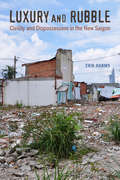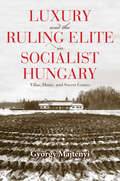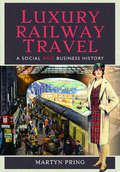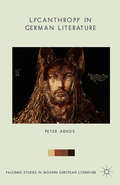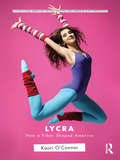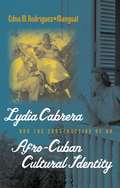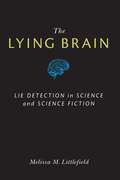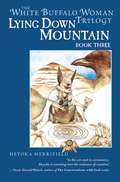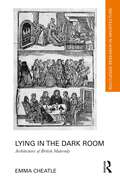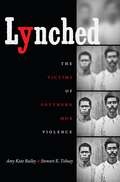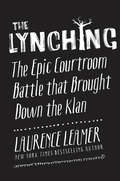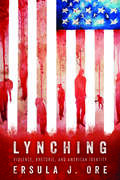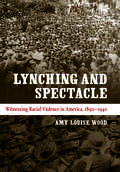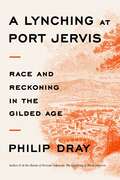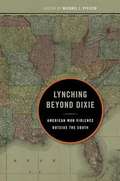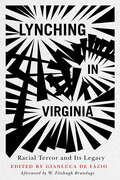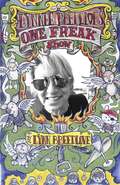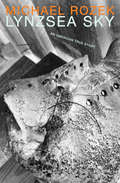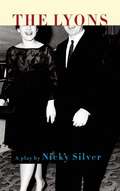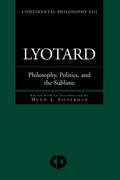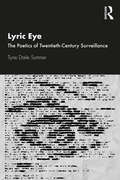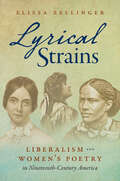- Table View
- List View
Luxury and Rubble: Civility and Dispossession in the New Saigon
by Erik HarmsA free ebook version of this title will be available through Luminos, University of California Press's open access publishing program for monographs. Visit www.luminosoa.org to learn more.Luxury and Rubble is the tale of two cities in Ho Chi Minh City. It is the story of two planned, mixed-use residential and commercial developments that are changing the face of Vietnam's largest city. Since the early 1990s, such developments have been steadily reorganizing urban landscapes across the country. For many Vietnamese, they are a symbol of the country's emergence into global modernity and of post-socialist economic reforms. However, they are also sites of great contestation, sparking land disputes and controversies over how to compensate evicted residents. In this penetrating ethnography, Erik Harms vividly portrays the human costs of urban reorganization as he explores the complex and sometimes contradictory experiences of individuals grappling with the forces of privatization in a socialist country.
Luxury and the Ruling Elite in Socialist Hungary: Villas, Hunts, and Soccer Games (Studies in Hungarian History)
by György MajtényiAfter World War II, a new community of elite emerged in Hungary, in spite of the communist principles espoused by the government. In Luxury and the Ruling Elite in Socialist Hungary, György Majtényi allows us a peek inside their affluence.Majtényi exposes the lavish standard of living that the higher echelon enjoyed, complete with pools, Persian rugs, extravagant furniture, servants, and groundskeepers. They shopped in private stores stocked with expensive meats and tropical fruits just for them. They benefited from access to everything from books, telephone lines, and international travel to hunting grounds, soccer games, and even the choicest cemetery plots. But Majtényi also reveals the underbelly of such society, particularly how these privileges were used as a way of maintaining power, initiating or denying entry to party members, and strengthening the very hierarchies that communism promised to abolish.Taking readers on a fascinating and often surprising look inside the manor homes and vacation villas of wealthy post–World War II Hungarians, Majtényi offers fresh insight into the realities of patriarchy, loyalty, gender, and class within the communist regime.
Luxury Railway Travel: A Social and Business History
by Martyn Pring&“Reads like an extravagant time travel through Britain&’s opulence era where train travel was just as stylish and fanciful as the elite class themselves.&” —Manhattan with a Twist Martyn Pring has carried out considerable research tracing the evolution of British luxury train travel weaving railway, social and travel history threads around a number of Britain&’s mainline routes traditionally associated with glamorous trains. Drawing on contemporary coverage, he chronicles the luxury products and services shaped by railway companies and hospitality businesses for Britain&’s burgeoning upper and middle classes and wealthy overseas visitors, particularly Americans, who demanded more civilized and comfortable rail travel. By Edwardian times, a pleasure-palace industry emerged as entrepreneurs, hotel proprietors, local authorities and railway companies all collaborated developing upscale destinations, building civic amenities, creating sightseeing and leisure pursuits and in place-making initiatives to attract prosperous patrons. Luxury named trains delivered sophisticated and fashionable settings encouraging a golden age of civilized business and leisure travel. Harkening back to the inter-war years, modern luxury train operators now redefine and capture the allure and excitement of dining and train travel experiences. &“Martyn&’s extraordinarily beautiful book is more than a collection of classic railway posters—it describes a way of life that&’s now lost in the mists of the twentieth century . . . As a piece of social history, this book is faultless, and a precious reminder of luxury and class distinction . . . [a] fabulous book. Exceptional.&” —Books Monthly &“A comprehensive account of luxury &‘hotel trains,&’ dining trains and the presentations of heritage railways brings the story to its unexpected conclusion . . . this is a lively take on a neglected topic.&” —BackTrack
Lycanthropy in German Literature (Palgrave Studies in Modern European Literature)
by Peter ArndsLycanthropy in German Literature argues that as a symbol of both power and parasitism, the human wolf of the Germanic Middle Ages is iconic to the representation of the persecution of undesirables in the German cultural imagination from the early modern age to the post-war literary scene.
Lycra: How A Fiber Shaped America (Routledge Series for Creative Teaching and Learning in Anthropology)
by Kaori O'Connor"The Anthropology of Stuff" is part of a new Series dedicated to innovative, unconventional ways to connect undergraduate students and their lived concerns about our social world to the power of social science ideas and evidence. Our goal with the project is to help spark social science imaginations and in doing so, new avenues for meaningful thought and action. Each "Stuff" title is a short (100 page) "mini text" illuminating for students the network of people and activities that create their material world. Lycra describes the development of a specific fabric, but in the process provides students with rare insights into U.S. corporate history, the changing image of women in America, and how a seemingly doomed product came to occupy a position never imagined by its inventors and contained in the wardrobe of virtually every American. And it will generate lively discussion of the story of the relationship between technology, science and society over the past half a century.
Lydia Cabrera and the Construction of an Afro-Cuban Cultural Identity
by Edna M. Rodríguez-PlateLydia Cabrera (1900-1991), an upper-class white Cuban intellectual, spent many years traveling through Cuba collecting oral histories, stories, and music from Cubans of African descent. Her work is commonly viewed as an extension of the work of her famous brother-in-law, Cuban anthropologist Fernando Ortiz, who initiated the study of Afro-Cubans and the concept of transculturation. Here, Edna Rodriguez-Mangual challenges this perspective, proposing that Cabrera's work offers an alternative to the hegemonizing national myth of Cuba articulated by Ortiz and others.Rodriguez-Mangual examines Cabrera's ethnographic essays and short stories in context. By blurring fact and fiction, anthropology and literature, Cabrera defied the scientific discourse used by other anthropologists. She wrote of Afro-Cubans not as objects but as subjects, and in her writings, whiteness, instead of blackness, is gazed upon as the "other." As Rodriguez-Mangual demonstrates, Cabrera rewrote the history of Cuba and its culture through imaginative means, calling into question the empirical basis of anthropology and placing Afro-Cuban contributions at the center of the literature that describes the Cuban nation and its national identity.
Lydia's Open Door: Inside Mexico's Most Modern Brothel
by Patty KellyIn this groundbreaking ethnographic study, Patty Kelly examines the lives of the women who work in the Zona Galactica, a state-run brothel in Chiapas's capital city. By delving into lives that would otherwise go unremarked, Kelly documents the modernization of the sex industry during the neoliberal era in the city of Tuxtla Gutiérrez and illustrates how state-regulated sex became part of a broader effort by government officials to bring modernity to Chiapas, one of Mexico's poorest and most conflicted states. Kelly's innovative approach locates prostitution in a political-economic context by treating it as work. Most valuably, she conveys her analysis through vivid portraits of the lives of the sex workers themselves and shows how the women involved are neither victims nor heroines.
The Lying Brain: Lie Detection and Science Fiction
by Melissa M. Littlefield"The Lying Brain is a study to take seriously. Its argument is timely, clear, and of particular importance to the enlargement of our understanding of the relationships among science studies, literary studies, and technology studies." ---Ronald Schleifer, University of Oklahoma. Real and imagined machines, including mental microscopes, thought translators, and polygraphs, have long promised to detect deception in human beings. Now, via fMRI and EEG, neuroscientists seem to have found what scientists, lawyers, and law enforcement officials have sought for over a century: foolproof lie detection. But are these new lie detection technologies any different from their predecessors? The Lying Brain is the first book to explore the cultural history of an array of lie detection technologies: their ideological assumptions, the scientific and fictional literatures that create and market them, and the literacies required for their interpretation. By examining a rich archive of materials about lie detection--from science to science fiction--The Lying Brain demonstrates the interconnections of science, literature, and popular culture in the development and dissemination of deception detection in the American cultural imagination. As Melissa Littlefield demonstrates, neuroscience is not building a more accurate lie detector; it is simply recycling centuries-old ideologies about deception and its detection.
Lying Down Mountain
by Heyoka MerrifieldIn this third volume of the White Buffalo Woman Trilogy, Heyoka Merrifield continues the story of White Buffalo Woman and her journey through the land of the Lying Down Mountain. Set in the home of the peaceful Hopi Nation and based on Hopi culture and mythology, Lying Down Mountain contains sacred wisdom of peace and spirituality that can bring tranquility to today's turbulent Mother Earth. The Native American saga begins with the first two volumes in the series, Eyes of Wisdom and Painted Earth Temple.
Lying in State: Why Presidents Lie -- And Why Trump Is Worse
by Eric AltermanThis definitive history of presidential lying reveals how our standards for truthfulness have eroded -- and why Trump's lies are especially dangerous.If there's one thing we know about Donald Trump, it's that he lies. But he's by no means the first president to do so. In Lying in State, Eric Alterman asks how we ended up with such a pathologically dishonest commander in chief, showing that, from early on, the United States has persistently expanded its power and hegemony on the basis of presidential lies. He also reveals the cumulative effect of this deception-each lie a president tells makes it more acceptable for subsequent presidents to lie-and the media's complicity in spreading misinformation. Donald Trump, then, represents not an aberration but the culmination of an age-old trend. Full of vivid historical examples and trenchant analysis, Lying in State is essential reading for anyone seeking to understand how we arrived in this age of alternative facts.
Lying in the Dark Room: Architectures of British Maternity (Routledge Research in Architecture)
by Emma CheatleLying in the Dark Room: Architectures of British Maternity returns to and reflects on the spatial and architectural experience of childbirth, through both a critical history of maternity spaces and a creative exploration of those we use today. Where conventional architectural histories objectify buildings (in parallel with the objectification of the maternal body), the book—in the mode of creative practice research—presents a creative-critical autotheory of the architecture of lying-in. It uses feminist, subjective modes of thinking that travel across disciplines, registers and arguments. The book assesses the transformation of maternity spaces—from the female bedchamber of seventeenth- and eighteenth-century marital homes, to the lying-in hospitals of the eighteenth and nineteenth centuries purposely built by man-midwives, to the late twentieth-century spaces of home and the modern hospital maternity wing—and the parallel shifts in maternal practices. The spaces are not treated as mute or neutral backdrops to maternal history but as a series of vital, entangled atmospheres, materials, practices and objects that are produced by, and, in turn, produce particular social and political conditions, gendered structures and experiences. Moving across spaces, systems, protagonists and their subjectivities, the book shows how hospital design and protocol altered ordinary birth at home and continues to shape maternal spatial experience today. As such, it will be of interest to a wide range of readers, from architectural historians, theoreticians, designers and students to medical humanities historians, to English Literature, humanities and material studies scholars, as well as those interested in creative-critical writing.
Lynched
by Amy Kate Bailey Stewart E. TolnayOn July 9, 1883, twenty men stormed the jail in Morehouse Parish, Louisiana, kidnapped Henderson Lee, a black man charged with larceny, and hanged him. Events like this occurred thousands of times across the American South in the late nineteenth and early twentieth centuries, yet we know scarcely more about any of these other victims than we do about Henderson Lee. Drawing on new sources to provide the most comprehensive portrait of the men and women lynched in the American South, Amy Bailey and Stewart Tolnay's revealing profiles and careful analysis begin to restore the identities of--and lend dignity to--hundreds of lynching victims about whom we have known little more than their names and alleged offenses.Comparing victims' characteristics to those of African American men who were not lynched, Bailey and Tolnay identify the factors that made them more vulnerable to being targeted by mobs, including how old they were; what work they did; their marital status, place of birth, and literacy; and whether they lived in the margins of their communities or possessed higher social status. Assessing these factors in the context of current scholarship on mob violence and reports on the little-studied women and white men who were murdered in similar circumstances, this monumental work brings unprecedented clarity to our understanding of lynching and its victims.
The Lynching: The Epic Courtroom Battle That Brought Down the Klan
by Laurence LeamerThe New York Times bestselling author of The Kennedy Women chronicles the powerful and spellbinding true story of a brutal race-based killing in 1981 and subsequent trials that undid one of the most pernicious organizations in American history--the Ku Klux Klan.On a Friday night in March 1981 Henry Hays and James Knowles scoured the streets of Mobile in their car, hunting for a black man. The young men were members of Klavern 900 of the United Klans of America. They were seeking to retaliate after a largely black jury could not reach a verdict in a trial involving a black man accused of the murder of a white man. The two Klansmen found nineteen-year-old Michael Donald walking home alone. Hays and Knowles abducted him, beat him, cut his throat, and left his body hanging from a tree branch in a racially mixed residential neighborhood.Arrested, charged, and convicted, Hays was sentenced to death--the first time in more than half a century that the state of Alabama sentenced a white man to death for killing a black man. On behalf of Michael's grieving mother, Morris Dees, the legendary civil rights lawyer and cofounder of the Southern Poverty Law Center, filed a civil suit against the members of the local Klan unit involved and the UKA, the largest Klan organization. Charging them with conspiracy, Dees put the Klan on trial, resulting in a verdict that would level a deadly blow to its organization.Based on numerous interviews and extensive archival research, The Lynching brings to life two dramatic trials, during which the Alabama Klan's motives and philosophy were exposed for the evil they represent. In addition to telling a gripping and consequential story, Laurence Leamer chronicles the KKK and its activities in the second half the twentieth century, and illuminates its lingering effect on race relations in America today.The Lynching includes sixteen pages of black-and-white photographs.
Lynching: Violence, Rhetoric, and American Identity (Race, Rhetoric, and Media Series)
by Ersula J. OreWinner of the 2020 Rhetoric Society of America Book AwardWhile victims of antebellum lynchings were typically white men, postbellum lynchings became more frequent and more intense, with the victims more often black. After Reconstruction, lynchings exhibited and embodied links between violent collective action, American civic identity, and the making of the nation.Ersula J. Ore investigates lynching as a racialized practice of civic engagement, in effect an argument against black inclusion within the changing nation. Ore scrutinizes the civic roots of lynching, the relationship between lynching and white constitutionalism, and contemporary manifestations of lynching discourse and logic today. From the 1880s onward, lynchings, she finds, manifested a violent form of symbolic action that called a national public into existence, denoted citizenship, and upheld political community.Grounded in Ida B. Wells’s summation of lynching as a social contract among whites to maintain a racial order, at its core, Ore’s book speaks to racialized violence as a mode of civic engagement. Since violence enacts an argument about citizenship, Ore construes lynching and its expressions as part and parcel of America’s rhetorical tradition and political legacy.Drawing upon newspapers, official records, and memoirs, as well as critical race theory, Ore outlines the connections between what was said and written, the material practices of lynching in the past, and the forms these rhetorics and practices assume now. In doing so, she demonstrates how lynching functioned as a strategy interwoven with the formation of America’s national identity and with the nation’s need to continually restrict and redefine that identity. In addition, Ore ties black resistance to lynching, the acclaimed exhibit Without Sanctuary, recent police brutality, effigies of Barack Obama, and the killing of Trayvon Martin.
Lynching and Spectacle: Witnessing Racial Violence in America, 1890-1940
by Amy Louise WoodLynch mobs in late nineteenth- and early twentieth-century America exacted horrifying public torture and mutilation on their victims. InLynching and Spectacle, Amy Wood explains what it meant for white Americans to perform and witness these sadistic spectacles and how lynching played a role in establishing and affirming white supremacy. Lynching, Wood argues, overlapped with a variety of cultural practices and performances, both traditional and modern, including public executions, religious rituals, photography, and cinema, all which encouraged the horrific violence and gave it social acceptability. However, she also shows how the national dissemination of lynching images ultimately fueled the momentum of the antilynching movement and the decline of the practice. Using a wide range of sources, including photos, newspaper reports, pro- and antilynching pamphlets, early films, and local city and church records, Wood reconfigures our understanding of lynching's relationship to modern life. Wood expounds on the critical role lynching spectacles played in establishing and affirming white supremacy at the turn of the century, particularly in towns and cities experiencing great social instability and change. She also shows how the national dissemination of lynching images fueled the momentum of the antilynching movement and ultimately led to the decline of lynching. By examining lynching spectacles alongside both traditional and modern practices and within both local and national contexts, Wood reconfigures our understanding of lynching's relationship to modern life.
A Lynching at Port Jervis: Race and Reckoning in the Gilded Age
by Philip DrayAn account of a lynching that took place in New York in 1892, forcing the North to reckon with its own racism.On June 2, 1892, in the small, idyllic village of Port Jervis, New York, a young Black man named Robert Lewis was lynched by a violent mob. The twenty-eight-year-old victim had been accused of sexually assaulting Lena McMahon, the daughter of one of the town's well-liked Irish American families. The incident was infamous at once, for it was seen as a portent that lynching, a Southern scourge, surging uncontrollably below the Mason-Dixon Line, was about to extend its tendrils northward. What factors prompted such a spasm of racial violence in a relatively prosperous, industrious upstate New York town, attracting the scrutiny of the Black journalist Ida B. Wells, just then beginning her courageous anti-lynching crusade? What meaning did the country assign to it? And what did the incident portend?Today, it’s a terrible truth that the assault on the lives of Black Americans is neither a regional nor a temporary feature, but a national crisis. There are regular reports of a Black person killed by police, and Jim Crow has found new purpose in describing the harsh conditions of life for the formerly incarcerated, as well as in large-scale efforts to make voting inaccessible to Black people and other minority citizens. The “mobocratic spirit” that drove the 2021 attack on the U.S. Capitol—a phrase Abraham Lincoln used as early as 1838 to describe vigilantism’s corrosive effect on America—frightfully insinuates that mob violence is a viable means of effecting political change. These issues remain as deserving of our concern now as they did a hundred and thirty years ago, when America turned its gaze to Port Jervis.An alleged crime, a lynching, a misbegotten attempt at an official inquiry, and a past unresolved. In A Lynching at Port Jervis, the acclaimed historian Philip Dray revisits this time and place to consider its significance in our communal history and to show how justice cannot be achieved without an honest reckoning.
Lynching Beyond Dixie: American Mob Violence Outside the South
by Michael J. PfeiferIn recent decades, scholars have explored much of the history of mob violence in the American South, especially in the years after Reconstruction. However, the lynching violence that occurred in American regions outside the South, where hundreds of persons, including Hispanics, whites, African Americans, Native Americans, and Asian Americans died at the hands of lynch mobs, has received less attention. This collection of essays by prominent and rising scholars fills this gap by illuminating the factors that distinguished lynching in the West, the Midwest, and the Mid-Atlantic. The volume adds to a more comprehensive history of American lynching and will be of interest to all readers interested in the history of violence across the varied regions of the United States. Contributors are Jack S. Blocker Jr., Brent M. S. Campney, William D. Carrigan, Sundiata Keita Cha-Jua, Dennis B. Downey, Larry R. Gerlach, Kimberley Mangun, Helen McLure, Michael J. Pfeifer, Christopher Waldrep, Clive Webb, and Dena Lynn Winslow.
Lynching in Virginia: Racial Terror and Its Legacy (The American South Series)
by W. Fitzhugh BrundageUncovering the history and examining the legacy of lynching in the state of Virginia Although not as associated with lynching as other southern states, Virginia has a tragically extensive history with these horrific crimes. This important volume examines the more than one hundred people who were lynched in Virginia between 1866 and 1932. Its diverse set of contributors—including scholars, journalists, activists, and students—recover this wider history of lynching in Virginia, interrogate its legacy, and spotlight contemporary efforts to commemorate the victims of racial terror across the commonwealth. Together, their essays represent a small part of the growing effort to come to terms with the role Virginia played in perpetuating America&’s national shame.
Lynching Reconsidered: New Perspectives in the Study of Mob Violence
by William D. CarriganThe history of lynching and mob violence has become a subject of considerable scholarly and public interest in recent years. Popular works by James Allen, Philip Dray, and Leon Litwack have stimulated new interest in the subject. A generation of new scholars, sparked by these works and earlier monographs, are in the process of both enriching and challenging the traditional narrative of lynching in the United States. This volume contains essays by ten scholars at the forefront of the movement to broaden and deepen our understanding of mob violence in the United States. These essays range from the Reconstruction to World War Two, analyze lynching in multiple regions of the United States, and employ a wide range of methodological approaches. The authors explore neglected topics such as: lynching in the Mid-Atlantic, lynching in Wisconsin, lynching photography, mob violence against southern white women, black lynch mobs, grassroots resistance to racial violence by African Americans, nineteenth century white southerners who opposed lynching, and the creation of 'lynching narratives' by southern white newspapers. This book was first published as a special issue of American Nineteenth Century History
Lynnee Breedlove's One Freak Show
by Lynn Breedlove"Breedlove has talent coming out of her ears."--Dodie Bellamy, San Francisco Chronicle"Uninhibited humor lends tender insight and perspective to a gender politics debate that often takes place in a fiercely contentious atmosphere."--Billy Tania, The San Francisco Bay Times"...Offers hilarious, gender-bending comedy that will spread much mirth among your LGBT friends."--Tucson WeeklyThrough the unusual vehicle of gender-bending comedy, Lynn Breedlove asks his audience, "Who truly owns and defines the body: self, family, or community?" Based on his critically acclaimed comedy performances, this laugh-out-loud collection of outrageous writing celebrates a lifelong defiance of categorization.With universal appeal, aimed at "Everyone who wants to be able to laugh at their preconceptions about themselves and others," the distinctive humor in Lynnee Breedlove's One Freak Show delightfully enlightens while challenging societal norms about love, identity, and community."Am I a man or a woman? What are you askin' me for . . . Do I look like I know?"Lambda Literary Award finalist Lynn Breedlove is known as lyricist and front thang for the queer punk band Tribe 8, and he is the author of the speed-driven bike messenger novel Godspeed. He has toured throughout the United States and Europe as a musician and comic performer. Winner of a Heritage Award for Creativity, Breedlove currently resides in San Francisco.
Lynzsea Sky: An American True Story
by Michael RozekLynzsea Sky, a twenty-something college student, tells the author her heartbreaking, disturbing, and culture-challenging life story. She speaks at first hesitantly, then with increasing clarity about sex, drugs, family life, education, tattoos, homelessness, her dreams of becoming a filmmaker, her brother's time in prison, and her mother's struggle with mental illness.<P><P>The book is just the conversation; the absence of anything else makes this a groundbreaking new form of nonfiction. The lean prose is void of stylistic hijinks, drawing the reader in without drawing attention to the writer.The author's first book is part of a planned series called American True Stories, all of which will be similarly dialogue based. Michael Rozek's work illuminates real American lives and gives a voice to people who often are overlooked by the mainstream media.Michael Rozek has written more than two thousand articles for various national magazines including Rolling Stone, Esquire, Sports Illustrated, and The Village Voice in a career spanning nearly forty years. He walked away from a lucrative free-lance career to publish the popular Rozek's Newsletter in the 1990s in response to the "fast food" journalism he saw increasingly creeping into American magazines. For more than a decade, Rozek and his wife Charlotte have struggled with homelessness and poverty, yet Rozek continues to talk to and write about everyday Americans with empathy and insight. This is his first book.
The Lyons
by Nicky Silver"Comedy nirvana . . . satisfyingly mean and funny."-New York Post"Without sacrificing his mordant wit or bleak worldview, this distinctive dramatist shows a new maturity and empathy in."?The New York Times"Nicky Silver's terrific play is filled with moments when you can't stop laughing even though the circumstances indicate you really shouldn't. . . . A wonderful little riff on family dysfunction."?Associated Press"Silver finds plenty of fresh bite, and the sheer savagery of his observation here is breathtaking. Watching it brings the dueling sensations of wicked mirth and squirming discomfort at being trapped in the hell of someone else's family horrors. That these are exaggerations of our own is what gives the play its teeth."-The Hollywood ReporterThis vicious, hilarious black comedy opened on Broadway in April 2012 to rave reviews.Nicky Silver, that "strange progeny of a coupling between Mr. Neil Simon and Edward Albee" (The New York Times), has cornered the market on deliciously savage dysfunctional family comedies. Following an acclaimed run Off-Broadway, this intimate and frightening examination of how we cope with loneliness and disappointment currently delights audiences on Broadway.Rita Lyons is the matriarch of a family facing a major crossroads. Her husband, Ben, is dying and her grown children are struggling. As the family gathers in Ben's hospital room, they discover that they're as terrified of being together as they are of being alone.
Lyotard: Philosophy, Politics and the Sublime (Continental Philosophy #Vol. 8)
by Hugh J. SilvermanFirst published in 2003. Routledge is an imprint of Taylor & Francis, an informa company.
Lyric Eye: The Poetics of Twentieth-Century Surveillance
by Tyne Daile SumnerLyric Eye: The Poetics of Twentieth-Century Surveillance presents the first detailed study of the relationship between poetry and surveillance. It critically examines the close connection between American lyric poetry and a burgeoning U.S. state surveillance apparatus from 1920 to the 1960s. The book explores the myriad ways that poets—Ezra Pound, William Carlos Williams, W.H. Auden, Langston Hughes, James Baldwin, Sylvia Plath, Gertrude Stein, Robert Lowell, Allen Ginsberg and others—explored a developing and fraught environment in which the growing power of American investigative agencies, such as the FBI under J. Edgar Hoover, imposed new pressures on cultural discourse and personal identity. In analysing twentieth-century American poetry and its various ideas about "the self," Lyric Eye demonstrates the extent to which poetry and surveillance employ similar styles of information gathering such as observation, overhearing, imitation, abstraction, repurposing of language, subversion, fragmentation and symbolism. Ground-breaking and prescient, this book will be of great interest to scholars and researchers of literature, politics, surveillance and intelligence studies, and digital humanities.
Lyrical Strains: Liberalism and Women's Poetry in Nineteenth-Century America
by Elissa ZellingerIn this book, Elissa Zellinger analyzes both political philosophy and poetic theory in order to chronicle the consolidation of the modern lyric and the liberal subject across the long nineteenth century. In the nineteenth-century United States, both liberalism and lyric sought self-definition by practicing techniques of exclusion. Liberalism was a political philosophy whose supposed universals were limited to white men and created by omitting women, the enslaved, and Native peoples. The conventions of poetic reception only redoubled the sense that liberal selfhood defined its boundaries by refusing raced and gendered others. Yet Zellinger argues that it is precisely the poetics of the excluded that offer insights into the dynamic processes that came to form the modern liberal and lyric subjects. She examines poets—Frances Sargent Osgood, Elizabeth Oakes Smith, Frances Ellen Watkins Harper, Edna St. Vincent Millay, and E. Pauline Johnson—whose work uses lyric practices to contest the very assumptions about selfhood responsible for denying them the political and social freedoms enjoyed by full liberal subjects. In its consideration of politics and poetics, this project offers a new approach to genre and gender that will help shape the field of nineteenth-century American literary studies.
